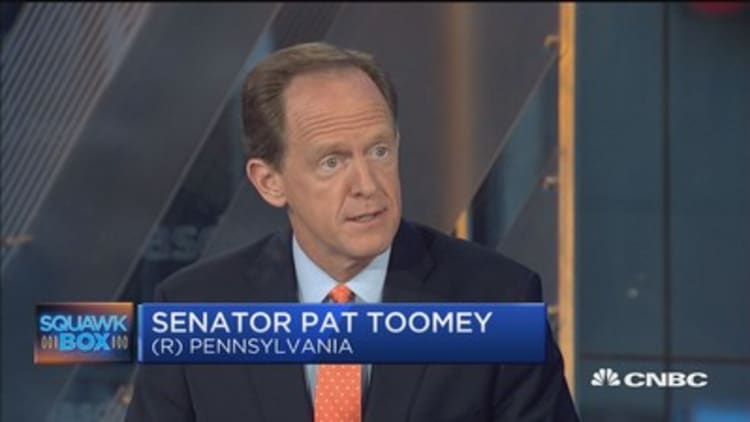If you expect to buy Obamacare health insurance next year, get ready for the very real possibility of having fewer insurers and plans to choose from. Obamacare customers in a number of states are on track to have reduced options for their health plans, according to data released this week by the federal government.
That data was immediately touted by officials in the Trump administration as offering proof that the Affordable Care Act is failing and that a new health-care law is badly needed.
If there are few or just one insurers in a given state, it means there is little or no competition, which can translate into higher prices for customers.
But Obamacare experts who spoke with CNBC suggested that fears about a collapsing individual health-plan market are overblown.
Those experts also suggested that the reduced competition between Obamacare insurers in a number of U.S. counties that could be seen next year is largely a result of nervousness among insurers that is being fanned by actions of the Trump administration.
"The marketplaces were widely viewed as stable or stabilizing in most states at the beginning of this year," said Sara Collins, a senior vice president at the Commonwealth Fund, a leading health-care research group.
"It is the uncertainty about Congress and the administration's implementation of reforms that are the primary source of the current problems in individual market," Collins said.

Even with that uncertainty, Collins and other experts said, the vast majority of Americans will have access to an Obamacare plan if they need it.
Most Americans do not buy, or need Obamacare coverage, because they have health insurance through another source: through job-based insurance plans or through Medicare or Medicaid.
But about 11 million people buy individual health plans through government-run marketplaces, such as HealthCare.gov, and millions more buy such plans outside of those exchanges. Both on-exchange and off-exchange individual plans comprise the Obamacare market.
On July 5 the federal Centers for Medicare and Medicaid Services, which oversees Obamacare, posted an updated Health Insurance Exchanges Issuer County Map.
That map shows projections for the level of insurer participation on Obamacare exchanges and is based on public announcement by insurers of their intentions as of July 3.
The map shows 40 U.S. counties, in Nevada, Indiana and Ohio, that are marked as red, indicating that no insurer as of now intends to sell Obamacare plans there in 2018.
Counties covering large or entire parts of 17 other states are on track to have just one insurer selling Obamacare plans next year. Alaska, Wyoming, Nebraska, Alabama, Mississippi and South Carolina are entirely in yellow, indicating just one insurer plans to sell Obamacare coverage in each of those states.
On the other hand, many northern states, including population-heavy New York, as well as California, are largely green or dark green, with green indicating three insurers selling plans and dark green indicating even more. Much of Florida, another state with a large population, has two or more insurers expected to sell plans.
Insurers flee exchanges
On Monday, CMS issued a new report showing that as of that day, just 141 insurers had submitted applications to sell plans on HealthCare.gov, the federally run exchange that serves residents of 39 states.
That is a 38 percent drop from the 227 insurers that filed initial applications to sell plans on HealthCare.gov for 2017.
And it is more than a 50 percent reduction in the number of initial applications filed by insurers for 2016.
"This is further proof that the Affordable Care Act is failing," said CMS Administrator Seema Verma.
More from America's Top States for Business:
States in crisis: worst budget battles since the Great Recession
America's best states to live in 2017
"Insurers continue to flee the exchanges, causing Americans to lose their choice for health insurance or lose their coverage altogether," Verma said. "These numbers are clear: The status quo is not working. The American people deserve health-care choices and access to quality, affordable health-care coverage."
But a less dire view came from Cynthia Cox, associate director at the Kaiser Family Foundation, where she conducts economic and policy research on the ACA.
"The individual insurance market was not a competitive market before the ACA passed," Cox said.
"It was common for one insurance company to dominate most of the state's individual market before the ACA and the same is true now," she said. "Generally speaking, the ACA hasn't improved individual market competition, but it hasn't worsened, either."
Cox pointed at data that she said backs up that claim.
"On average in 2013 [the years before Obamacare plans first were sold], states had four sizable individual market insurance companies, and in 2016, the most recent year of data, the same was true," Cox said.
"In 2013 the largest company controlled 58 percent of the market, and in 2016 it was essentially the same at 57 percent," she said.
Cox added that the ACA barred insurers from competing with one another by avoiding covering sick people or by charging them higher premiums for health plans.
So even in counties with only one exchange insurer, sicker and older people in those counties probably have more options than they did before the ACA," she said.
The 33 percent
While there are some counties that are at risk of having no insurers, most of the counties that once were running that risk "of being bare" have end up getting an insurer to sell plans, she said.
Cox also noted that only "about 0.2 percent of exchange enrollees live" in counties currently projected as bar.
"So this is not a widespread issue," she said. "But it is important nonetheless because without an insurer on the exchange in these counties lower income people are unlikely to have an affordable option for insurance."
Sara Collins of the Commonwealth Fund noted that in the past there is "wide variation across the states" in the number of insurers selling plans.
Five states "had just one insurer" this year, Collins said, but there were 15 insurers selling plans in Wisconsin.
Still, Collins said, 33 percent of U.S. counties had just a single insurer selling Obamacare plans in 2017.
"This translates into about 21 percent of marketplace enrollees," or people who buy Obamacare from a government-run exchange. That is "up from 2 percent" of enrollees in 2016.
"This is clearly a concern heading into the 2018 plan year if a sole participant pulls out of these markets," Collins said.
What's driving insurers
Collins said there were several factors that led to a winnowing of insurers selling plans this year.
They include "stiff price competition," the curtailment of billions of dollars' worth of federal payments to insurers to compensate them for covering risky customers, and "low enrollment in some markets, especially rural" ones.
Both Collins and Cox said insurer participation in Obamacare markets could decrease next year because of looming question of Trump administration actions.
Specifically, they said, insurers are not sure whether the Trump administration and Congress will continue paying them billions of dollars in so-called cost-sharing reduction subsidies.
By law, insurers must give low-income Obamacare customers who buy certain kinds of health plans, known as silver plan, reduced charges for out-of-pocket health expenses, including co-pays, coinsurance and deductibles.
The federal government is supposed to reimburse insurers 100 percent for those subsidies. But a court case challenging the Obama administration's spending of that money without specific congressional appropriation of those fund, as well as President Donald Trump's musing that he might end the CSR payments that give consumers discounts, have led some insurers to hike prices significantly for 2018 or pull out of the Obamacare markets altogether.
Big insurer Anthem last month said it would effectively exit Ohio's individual plan market next year because of the CSR question, as well as other issues.
Anthem's departure left more than 15 Ohio counties on track to have no insurers selling Obamacare in 2018.
Another big question for insurers is whether Obamacare's individual mandate, which requires most Americans to have some form of insurance or pay a tax penalty, will either be repealed by a new Republican health-care law or not be enforced by the Trump administration.
"Insurers need to know the rules of the game for next year," Cox said.
"If they don't know the rules, some won't want to play at all and others will have to raise rates much higher than they otherwise would," Cox said.
More from Top States:
Complete coverage of the states and the issues
10 best states in America to live in
10 worst states in America to live in







